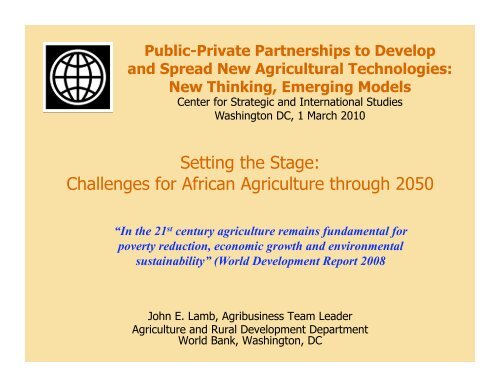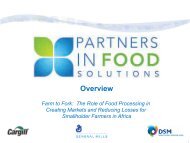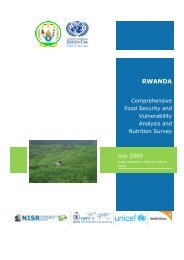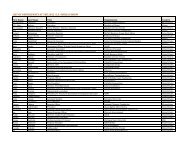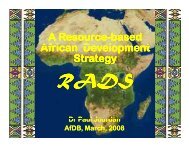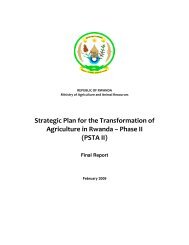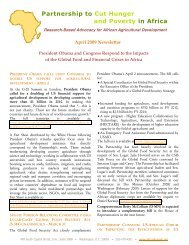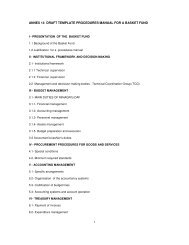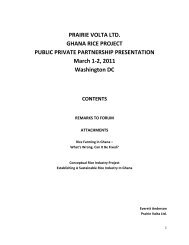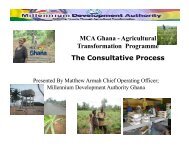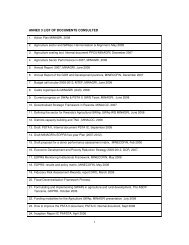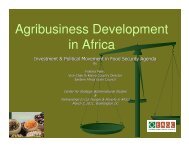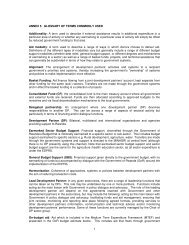March 1 Presentation.pdf - Partnership to Cut Hunger and Poverty in ...
March 1 Presentation.pdf - Partnership to Cut Hunger and Poverty in ...
March 1 Presentation.pdf - Partnership to Cut Hunger and Poverty in ...
You also want an ePaper? Increase the reach of your titles
YUMPU automatically turns print PDFs into web optimized ePapers that Google loves.
Public-Private <strong>Partnership</strong>s <strong>to</strong> Develop<br />
<strong>and</strong> Spread New Agricultural Technologies:<br />
New Th<strong>in</strong>k<strong>in</strong>g, Emerg<strong>in</strong>g Models<br />
Center for Strategic <strong>and</strong> International Studies<br />
Wash<strong>in</strong>g<strong>to</strong>n DC, 1 <strong>March</strong> 2010<br />
Sett<strong>in</strong>g the Stage:<br />
Challenges for African Agriculture through 2050<br />
“In the 21 st century agriculture rema<strong>in</strong>s fundamental for<br />
poverty reduction, economic growth <strong>and</strong> environmental<br />
susta<strong>in</strong>ability” (World Development Report 2008<br />
John E. Lamb, Agribus<strong>in</strong>ess Team Leader<br />
Agriculture <strong>and</strong> Rural Development Department<br />
World Bank, Wash<strong>in</strong>g<strong>to</strong>n, DC
World Development Report 2008<br />
Agriculture fulfills<br />
multiple functions <strong>in</strong> development<br />
Trigger of growth<br />
Source of livelihoods<br />
Provider <strong>and</strong> user of<br />
environmental services<br />
2
World Development Report 2008<br />
Agriculture matters because poverty<br />
<strong>and</strong> hunger are still rural<br />
N.B. Global extreme poverty (2002)=
World Development Report 2008<br />
Agriculture rema<strong>in</strong>s the best means<br />
of impact<strong>in</strong>g rural poverty & hunger<br />
GDP growth from agriculture<br />
benefits the <strong>in</strong>come of the<br />
poor 2-4 times more than<br />
GDP growth from nonagriculture<br />
(43 country study)<br />
4
World Development Report 2008<br />
Why is agriculture so powerful?<br />
Multiplier effects <strong>in</strong> the rural economy<br />
Increased<br />
Agricultural<br />
Growth<br />
Intermediate<br />
Consumption<br />
Outlays<br />
Payment of Rent,<br />
Labor, etc<br />
Sale of Goods<br />
<strong>and</strong> Services<br />
(esp. rural)<br />
Intermediate<br />
Consumption<br />
Outlays<br />
Decreased<br />
<strong>Poverty</strong><br />
&<br />
Payment of Rent,<br />
Labor, etc<br />
<strong>Hunger</strong><br />
Increased Net Farm<br />
Income<br />
Income from Rural<br />
Non-farm Enterprises
Direct <strong>and</strong> <strong>in</strong>direct impacts from sale of “tradables” +<br />
<strong>in</strong>duced effects from “non-tradables”=1.8 or more<br />
World Development Report 2008<br />
Increased<br />
Agricultural<br />
Growth<br />
Type 2: Indirect<br />
Employment Impacts<br />
Intermediate<br />
Consumption<br />
Outlays<br />
Payment of Rent,<br />
Labor, etc<br />
Sale of Goods<br />
<strong>and</strong> Services<br />
(esp. rural)<br />
Intermediate<br />
Consumption<br />
Outlays<br />
Payment of Rent,<br />
Labor, etc<br />
Decreased<br />
<strong>Poverty</strong><br />
&<br />
<strong>Hunger</strong><br />
Type 1: Direct<br />
Employment Impact<br />
Increased Net Farm<br />
Income<br />
Income from Rural<br />
Non-farm Enterprises<br />
Type 3: Induced<br />
Income Impacts
Yet governments <strong>in</strong> agriculture-based countries<br />
have not been <strong>in</strong>vest<strong>in</strong>g enough…<br />
World Development Report 2008<br />
Ag GDP/GDP<br />
..<strong>and</strong> sometimes the quality of public<br />
<strong>in</strong>vestment has been an issue
Unfortunately donors also reduced their<br />
agricultural <strong>in</strong>vestment <strong>in</strong> the N<strong>in</strong>eties….<br />
World Development Report 2008<br />
ODA <strong>in</strong> agriculture: value <strong>and</strong> share of <strong>to</strong>tal ODA, 1970-2007
…more rapidly than the decl<strong>in</strong>e <strong>in</strong> rural poverty<br />
World Development Report 2008<br />
% Rural <strong>Poverty</strong><br />
% ODA <strong>to</strong><br />
Agriculture
Arguably technological advances <strong>and</strong> area<br />
expansion led <strong>to</strong> public sec<strong>to</strong>r complacency…<br />
World Development Report 2008<br />
10
…underst<strong>and</strong>able perhaps,<br />
given progress achieved with maize …<br />
World Development Report 2008<br />
28.7<br />
0.7<br />
8.54<br />
8.93<br />
Corn<br />
Area<br />
(Millions<br />
of Has.)<br />
1.2<br />
1.7<br />
1.2<br />
2.3<br />
0.4<br />
24.1<br />
4.81<br />
5.29<br />
7.80<br />
7.24<br />
6.96<br />
6.52<br />
1.1<br />
1.1<br />
3.69<br />
4.18<br />
The Top 10 Countries<br />
Metric Tons per Hectare<br />
Source: Ganesh Kishore, Meet<strong>in</strong>g the Ag Science <strong>and</strong> Technology Challenges<br />
of the 21 st Century, S<strong>in</strong>gapore, 2009
..yet we all should have paid more attention <strong>to</strong><br />
global trends <strong>in</strong> the other major cereals…<br />
World Development Report 2008<br />
Rice<br />
1980s: 3.1% per year<br />
1990s: 1.4% per year<br />
2000s: 0.8% per year<br />
Wheat<br />
1980s: 2.9% per year<br />
1990s: 0.9% per year<br />
2000s: 0.4% per year
…<strong>and</strong> especially what was happen<strong>in</strong>g <strong>to</strong> growth<br />
rates of all cereal yields <strong>in</strong> develop<strong>in</strong>g countries<br />
World Development Report 2008
The WBG has recognized this <strong>and</strong> reversed the<br />
trend <strong>in</strong>ternally, while urg<strong>in</strong>g others <strong>to</strong> do so<br />
World Development Report 2008<br />
Sec<strong>to</strong>r Strategy:<br />
Reach<strong>in</strong>g The<br />
Rural Poor (2003)<br />
Agriculture Action Plan<br />
(2010-12) from $4.1 B<br />
<strong>to</strong> $6.2-8.3 B <strong>in</strong> lend<strong>in</strong>g<br />
operations <strong>to</strong>:<br />
1. Reduce risk <strong>and</strong> vulnerability<br />
2. Raise agricultural productivity<br />
3. L<strong>in</strong>k farmers <strong>to</strong> markets <strong>and</strong><br />
strengthen value cha<strong>in</strong>s<br />
Agriculture for Development<br />
4. Facilitate rural non-farm <strong>in</strong>come<br />
<strong>and</strong> diversification/exit<br />
5. Render environmental services<br />
14
World Development Report 2008<br />
The fund<strong>in</strong>g gap <strong>to</strong> meet MDG goals is<br />
substantial, all around<br />
Source: Global Perspectives Study Unit, FAO, 1 Oc<strong>to</strong>ber 2009
SSA alone needs much more <strong>in</strong>vestment <strong>in</strong><br />
agriculture <strong>and</strong> <strong>in</strong>frastructure<br />
World Development Report 2008<br />
About $7-9 billion<br />
annually <strong>in</strong> ag R&D<br />
Another $O.7 billion<br />
annually for<br />
irrigation<br />
Perhaps $10 billion<br />
annually for<br />
transport<br />
16
FDI rose sharply from 2003-2007, especially <strong>in</strong><br />
developed economies but also develop<strong>in</strong>g<br />
World Development Report 2008<br />
17
..yet the distribution across regions <strong>and</strong> even<br />
with<strong>in</strong> them varied widely…<br />
World Development Report 2008<br />
18
…<strong>and</strong> the share for primary agriculture was small <strong>in</strong><br />
absolute terms <strong>and</strong> compared <strong>to</strong> food <strong>and</strong> beverages<br />
World Development Report 2008<br />
Estimated FDI agriculture, forestry <strong>and</strong> fisheries, <strong>and</strong> <strong>in</strong> food <strong>and</strong> beverages, 1989-2007<br />
(billions of dollars <strong>and</strong> percent)<br />
Source: World Investment Report 2009, UNCTAD<br />
19
Ris<strong>in</strong>g agricultural commodity prices sparked<br />
renewed <strong>in</strong>terest <strong>in</strong> agro<strong>in</strong>vestment…<br />
World Development Report 2008<br />
Price (US$/metric <strong>to</strong>n)<br />
Price (US$/barrel)<br />
Sources: Corn, rice, sugar, <strong>and</strong> oilseeds for 1990–2005 - OECD 2005; 2006-07 – WB 2007<br />
Crude oil - IMF 2007, all as quoted by Rosegrant, 2008
…partly <strong>in</strong> response <strong>to</strong> the ris<strong>in</strong>g share of<br />
agricultural production go<strong>in</strong>g <strong>to</strong> non-food uses…<br />
World Development Report 2008<br />
US used 80 million <strong>to</strong>ns of corn (24%) for<br />
ethanol <strong>in</strong> 2007 <strong>and</strong> around 100 million <strong>in</strong> 2008<br />
(31%)<br />
In effect, 75% of <strong>in</strong>crease <strong>in</strong> global corn<br />
production from 2004-07 went for ethanol <strong>in</strong> US<br />
Biodiesel used about 9 million <strong>to</strong>ns of vegetable<br />
oils <strong>in</strong> 2008 (7% of global supplies)<br />
Brazil used about 55% of sugar cane for<br />
ethanol, but sugar exports rema<strong>in</strong>ed adequate<br />
<strong>to</strong> prevent major price <strong>in</strong>creases<br />
21
…partly because there are natural constra<strong>in</strong>ts<br />
<strong>in</strong> terms of grow<strong>in</strong>g conditions,…<br />
World Development Report 2008<br />
40% <strong>to</strong>o dry 21% <strong>to</strong>o wet 21% <strong>to</strong>o cold<br />
6% <strong>to</strong>o rough terra<strong>in</strong> 2% unsuitable soils<br />
Source: adapted from Robert Thompson, Global Harvest Initiative presentation, 2009
…man-made problems like soil degradation…<br />
World Development Report 2008<br />
23
World Development Report 2008<br />
…<strong>and</strong> excessive water consumption…<br />
24
(agriculture is the biggest user of water by far)<br />
World Development Report 2008<br />
Agricultural uses<br />
account for almost<br />
70% of global water<br />
withdrawals<br />
The <strong>to</strong>p 5 geographic<br />
units account for 60% of<br />
the <strong>to</strong>tal irrigated l<strong>and</strong> are<br />
of 2.77 million km2<br />
Irrigation is the<br />
largest use with<strong>in</strong><br />
agriculture<br />
India 558,080<br />
Ch<strong>in</strong>a 545,960<br />
USA 223,850<br />
Pakistan 182,300<br />
EU 168,050<br />
25
…all exacerbated by climate change<br />
impacts on agriculture<br />
Greater variability <strong>in</strong> weather<br />
Less precipitation <strong>and</strong> groundwater <strong>in</strong><br />
some areas, with longer droughts<br />
Excess ra<strong>in</strong>fall <strong>in</strong> other areas, with<br />
<strong>in</strong>creased flood<strong>in</strong>g, loss of coastal areas<br />
Reduction <strong>in</strong> crop yields <strong>and</strong> agriculture<br />
productivity <strong>in</strong> some produc<strong>in</strong>g areas<br />
Increased spread/life of pests/diseases<br />
Lower lives<strong>to</strong>ck productivity <strong>and</strong> higher<br />
production cost<br />
Lower availability of human resource <strong>and</strong><br />
lower labor productivity<br />
World Development Report 2008
So there is a grow<strong>in</strong>g sense that the planet may<br />
face a long-term, perhaps chronic problem…<br />
World Development Report 2008<br />
We need <strong>to</strong><br />
double cereal<br />
production by<br />
2050 <strong>to</strong> feed<br />
9.3 B people<br />
(versus 6+<br />
billions at the<br />
present time)<br />
27
World Development Report 2008<br />
…the solution <strong>to</strong> which is not clear<br />
About 10% of cereal production growth<br />
may come from area expansion (from the<br />
current level of 3.75 billion hectares)<br />
Maybe 20% from <strong>in</strong>tensification based on<br />
irrigation, cultural practices, multiple<br />
cropp<strong>in</strong>g, etc<br />
So the rema<strong>in</strong><strong>in</strong>g 70%<br />
must come from <strong>in</strong>novation<br />
Uhhh., is that<br />
evcn possible?<br />
28
One key <strong>to</strong> the future of agriculture is biotechnology,<br />
which has become a major driver of growth<br />
World Development Report 2008<br />
Breed<strong>in</strong>g<br />
Biotech<br />
• ↑ productivity (complex)<br />
• ↑ reliability Seed - carrier<br />
• ↑ quality of genetic <strong>in</strong>formation<br />
• Integration of native <strong>and</strong> biotech traits<br />
Traits<br />
Agrobacterium<br />
Gene Gun<br />
• Pest protection<br />
• Stress alleviation<br />
• Superior nutrient use<br />
• Enhanced nutrient density<br />
• Elevated safety<br />
• Processor friendly<br />
Source: DuPont<br />
Corn Yields<br />
U.S. Average Bu/Ac<br />
Biotech<br />
Chemistry<br />
• Pest control<br />
• Nutrition<br />
• Growth regula<strong>to</strong>rs<br />
Nearly 150 M acres not <strong>in</strong><br />
corn cultivation !<br />
Adapted from Ganesh Kishore, Meet<strong>in</strong>g the Ag Science <strong>and</strong> Technology<br />
Challenges of the 21 st Century, S<strong>in</strong>gapore, 2009
…another key is agro-enterprise <strong>in</strong>vestment,<br />
which can br<strong>in</strong>g many benefits if done right…<br />
World Development Report 2008<br />
√ Capital deepen<strong>in</strong>g <strong>and</strong> broaden<strong>in</strong>g<br />
√ Better production, post-harvest h<strong>and</strong>l<strong>in</strong>g,<br />
process<strong>in</strong>g technology<br />
√ Better product quality<br />
√ BOP value propositions <strong>in</strong>clud<strong>in</strong>g food fortification<br />
√ Creation or stimulation of a local market<br />
√ Modern management know-how<br />
√ Investment <strong>in</strong> collateral bus<strong>in</strong>esses<br />
√ Cross-cutt<strong>in</strong>g productive <strong>in</strong>frastructure
World Development Report 2008<br />
…<strong>and</strong> export-oriented agro-<strong>in</strong>vestment<br />
can br<strong>in</strong>g still more benefits…<br />
√ Introduction of scale <strong>and</strong> other economies<br />
√ Better quality assurance systems<br />
√ Adherence <strong>to</strong> WTO SPS commitments<br />
√ Compliance with private food safety,<br />
environmental <strong>and</strong> social requirements<br />
√ L<strong>in</strong>kages <strong>to</strong> larger, more diverse markets, coupled<br />
with traceability<br />
√ Value –addition through <strong>in</strong>novation <strong>in</strong> products<br />
<strong>and</strong> processes as well as br<strong>and</strong><strong>in</strong>g<br />
√ Improved social services <strong>in</strong> rural areas not easily<br />
served by government
..yet the recent upsurge <strong>in</strong> agro<strong>in</strong>vestment <strong>in</strong><br />
develop<strong>in</strong>g countries has been controversial<br />
World Development Report 2008<br />
Le « Néocolonialisme Agraire »<br />
Gagne du Terra<strong>in</strong> dans le Monde<br />
23 September 2008<br />
“Farml<strong>and</strong> Scramble”<br />
19 November 2009<br />
“Is There Such a Th<strong>in</strong>g as Agro-Imperialism?”<br />
16 November 2009<br />
“Conflicts over Natural<br />
Resources will Grow”<br />
“The Water Rights Grab: Big Bus<strong>in</strong>ess,<br />
Inves<strong>to</strong>rs Push for Privatization”<br />
“Global Warm<strong>in</strong>g is Real” blog<br />
13 November 2009<br />
13 November 2009<br />
32
…so it is critical that agroenterprise stay<br />
faithful <strong>to</strong> its Mission, which is…<br />
World Development Report 2008<br />
To responsibly <strong>and</strong> susta<strong>in</strong>ably grow, pack,<br />
process, <strong>and</strong> deliver consistently <strong>to</strong> consumers<br />
<strong>and</strong> other users…<br />
…food, feed, fiber, <strong>and</strong> biomass <strong>in</strong> sufficient<br />
quantity<br />
…that is safe <strong>to</strong> consume, compliant with<br />
applicable regulations, <strong>and</strong> <strong>in</strong> conformity with<br />
buyer needs <strong>and</strong> expectations…<br />
…at prices that are viable over time for both<br />
seller <strong>and</strong> buyer<br />
33
International agencies are fram<strong>in</strong>g an<br />
appropriate response <strong>to</strong> pressures on l<strong>and</strong>….<br />
World Development Report 2008
…seek<strong>in</strong>g a consensus around m<strong>in</strong>imal, good<br />
<strong>and</strong> eventually best practices…<br />
World Development Report 2008<br />
Public sec<strong>to</strong>r<br />
Acceptable<br />
behavior<br />
relat<strong>in</strong>g <strong>to</strong><br />
l<strong>and</strong>-extensive<br />
agroenterprise<br />
Civil society<br />
35
…so far seven key pr<strong>in</strong>ciples for Responsible<br />
Agro<strong>in</strong>vestment have emerged, center<strong>in</strong>g on …<br />
World Development Report 2008<br />
1. L<strong>and</strong> <strong>and</strong> Resource Rights<br />
2. Food Security<br />
3. Transparency, Good Governance <strong>and</strong> Enabl<strong>in</strong>g<br />
Environment<br />
4. Consultation <strong>and</strong> Participation<br />
5. Economic Viability <strong>and</strong> Responsible Inves<strong>to</strong>r<br />
Behavior<br />
6. Social Susta<strong>in</strong>ability<br />
7. Environmental Susta<strong>in</strong>ability<br />
36
World Development Report 2008<br />
Annex 1:<br />
Details Slides for Each RAI Pr<strong>in</strong>ciple
World Development Report 2008<br />
Pr<strong>in</strong>ciple 1: L<strong>and</strong> Rights<br />
Exist<strong>in</strong>g rights <strong>to</strong> l<strong>and</strong> <strong>and</strong> natural resources are recognized <strong>and</strong> respected.<br />
This depends on:<br />
(i) Proper identification of all rights holders<br />
(ii) Legal recognition demarcation <strong>and</strong> registration/record<strong>in</strong>g<br />
(iii) Direct <strong>and</strong> <strong>in</strong>formed negotiation with l<strong>and</strong> holders/users<br />
(iv) Fair <strong>and</strong> prompt payment for all acquired rights<br />
(v) Independent avenues for resolv<strong>in</strong>g disputes or grievances<br />
38
World Development Report 2008<br />
Pr<strong>in</strong>ciple 2: Food Security<br />
Investments do not jeopardize food security, but rather strengthen it.<br />
Protect<strong>in</strong>g food security requires that governments <strong>and</strong> <strong>in</strong>ves<strong>to</strong>rs:<br />
(i) Ensure at least equivalent access <strong>to</strong> food by affected<br />
populations<br />
(ii) Exp<strong>and</strong> opportunities for outgrower/off-farm employment<br />
(iii) Adopt strategies <strong>to</strong> prevent food shortages/reduce risks<br />
(iv) Consider impacts on national food security <strong>in</strong> design/<br />
approval<br />
39
World Development Report 2008<br />
Pr<strong>in</strong>ciple 3: Transparency<br />
Processes for access<strong>in</strong>g l<strong>and</strong> <strong>and</strong> mak<strong>in</strong>g associated <strong>in</strong>vestments are<br />
transparent, moni<strong>to</strong>red, <strong>and</strong> ensure accountability by all stakeholders.<br />
Public <strong>and</strong> private sec<strong>to</strong>r policies, rules, <strong>and</strong> practices should ensure that:<br />
(i) All relevant <strong>in</strong>formation is publicly available<br />
(ii) Institutions have capacity <strong>to</strong> operate efficiently <strong>and</strong><br />
transparently, practice good governance, & are audited<br />
(iii) An <strong>in</strong>dependent system <strong>to</strong> moni<strong>to</strong>r progress <strong>to</strong>wards a<br />
better <strong>in</strong>vestment climate is <strong>in</strong> place<br />
40
World Development Report 2008<br />
Pr<strong>in</strong>ciple 4: Consultation<br />
All those materially affected are consulted <strong>and</strong><br />
agreements from consultations are recorded <strong>and</strong> enforced.<br />
This requires clarity on:<br />
(i) Procedural requirements<br />
(ii) The character of agreements reached <strong>in</strong> such<br />
consultations<br />
(iii) How the agreements can be enforced<br />
41
World Development Report 2008<br />
Pr<strong>in</strong>ciple 5: Responsible Invest<strong>in</strong>g<br />
Projects are viable economically, respect the rule of law, reflect<br />
<strong>in</strong>dustry best practice, <strong>and</strong> result <strong>in</strong> durable shared value.<br />
All <strong>in</strong>ves<strong>to</strong>rs (whether private or government-l<strong>in</strong>ked) should:<br />
(i) Comply with laws, <strong>in</strong>ternational treaties, best practices<br />
(ii) Adhere <strong>to</strong> global best practices<br />
(iii) Aim <strong>to</strong> <strong>in</strong>crease shareholder value & benefit host area<br />
Governments must also assess economic viability <strong>in</strong> a cost-effective<br />
way <strong>and</strong> <strong>in</strong>tegrate major projects <strong>in</strong><strong>to</strong> broader development strategies.<br />
42
World Development Report 2008<br />
Pr<strong>in</strong>ciple 6: Social Susta<strong>in</strong>ability<br />
Investments generate desirable social <strong>and</strong><br />
distributional impacts <strong>and</strong> do not <strong>in</strong>crease vulnerability.<br />
Social susta<strong>in</strong>ability can be enhanced if governments <strong>and</strong> <strong>in</strong>ves<strong>to</strong>rs:<br />
(i) Identify social issues/risks—<strong>and</strong> strategies <strong>to</strong> mitigate<br />
these <strong>and</strong> <strong>in</strong>crease social benefits—dur<strong>in</strong>g preparation<br />
(ii) Consider <strong>in</strong>terests of vulnerable groups & women<br />
(iii) Include provision of local public goods <strong>in</strong> project design<br />
43
Pr<strong>in</strong>ciple 7: Environmental Susta<strong>in</strong>ability<br />
World Development Report 2008<br />
Environmental impacts due <strong>to</strong> a project are quantified <strong>and</strong><br />
measures taken <strong>to</strong> encourage susta<strong>in</strong>able resource use, while<br />
m<strong>in</strong>imiz<strong>in</strong>g the risk/magnitude of negative impacts <strong>and</strong> mitigat<strong>in</strong>g them.<br />
It is crucial that <strong>in</strong>ves<strong>to</strong>rs <strong>and</strong> government collaborate <strong>to</strong>:<br />
(i) Conduct <strong>in</strong>dependent environmental impact analysis prior<br />
<strong>to</strong> approval<br />
(ii) Promote <strong>in</strong>creas<strong>in</strong>g productivity on already used areas<br />
(iii) Use production systems that enhances resource efficiency<br />
(iv) Ensure that good practices are followed<br />
(v) Encourage beneficial ecosystem services<br />
(vi) Address negative impacts via env. managment plans.<br />
44


